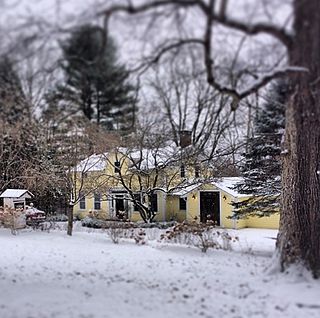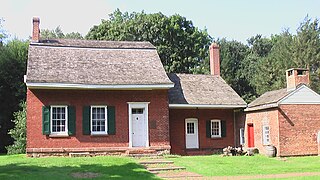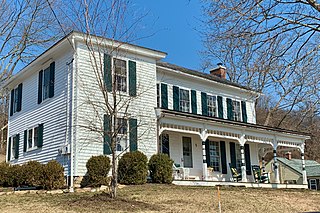
The Queens County Farm Museum, also known as Queens Farm, is a historic farm located on 47 acres (190,000 m2) of the neighborhoods of Floral Park and Glen Oaks in Queens, New York City. The farm occupies the city's largest remaining tract of undisturbed farmland, and is still a working farm today. Queens Farm practices sustainable agriculture and has a four-season growing program. The museum includes the Adriance Farmhouse, a New York City Landmark on the National Register of Historic Places.

Phineas Davis Farmstead is a historic farm complex and national historic district located in the village of Mexico in Oswego County, New York. The district features an Italianate farmhouse built in 1874. Also on the property is a historic henhouse and three stone hitching posts.

Hamilton Farmstead is a historic farm complex and national historic district located at Mexico in Oswego County, New York. The district includes three contributing structures; the farmhouse, a barn, and a milkhouse; and three hand-dug wells. The farmhouse is a three bay, two story cobblestone building built in 1848 in the Greek Revival style.
Slack Farmstead is a historic farm complex and national historic district located at Mexico in Oswego County, New York. The district includes four contributing structures; the farmhouse, a dairy barn (1870), granary and a hen house. Also on the property are a contributing stone wall, hand-dug well, and farm pond. The farmhouse is a five-bay, 1+1⁄2-story frame building with a gable roof built about 1838.

Stillman Farmstead is a historic farm complex and national historic district located at Mexico in Oswego County, New York. The district includes three contributing structures; the farmhouse, a mid-19th-century barn (1840), and a large garage. The farmhouse is a 2+1⁄2-story frame building built in 1889 in the Queen Anne style.

Thayer Farmstead is a historic farm complex and national historic district located at Mexico in Oswego County, New York. The district includes two contributing structures; the farmhouse and horse barn with small carriage shed. Also on the property are a contributing The farmhouse is composed of a two-story central section flanked by symmetrical one story wings. It is a frame building built about 1836.
Burns Family Farm is a historic farm and national historic district located at Bovina in Delaware County, New York. The district contains seven contributing buildings, one contributing site, and one contributing structures. It includes the Burns family farmhouse dating to 1833, 1+1⁄2-story frame stable, three-level dairy barn, a gable-roofed frame schoolhouse, and smaller outbuildings.

Hubbell Family Farm and Kelly's Corners Cemetery is a historic farm complex, cemetery, and national historic district located at Kelly's Corners, Delaware County, New York. The district contains 19 contributing buildings, two contributing sites, and four contributing structures.

Blydenburgh Park Historic District is a national historic district located at Smithtown in Suffolk County, New York. The district includes eight contributing buildings and one contributing structure. There are two groups of historic buildings: the mill complex and Blydenburgh Farmhouse and related buildings.

Bruyn Estate at Red Mills Farm or "Miller's House at Red Mills Farm" is a historic estate and farm located in Shawangunk in Ulster County, New York. Situated on just under 25 acres, Bruyn Estate has two residential dwellings totaling eight bedrooms. One 1835 Greek Revival farmhouse (3BR) on the National Register, and one newly built Log Home made from salvaged, antique 1850s barns, surrounded by landscaped lawns and outdoor event spaces. It is on the east side of the Shawangunk Kill at the Ulster/Orange Counties line. Wallkill Avenue is north of the building with the Shawangunk Kill east of it.

The Blauvelt House is a historic house and farm complex located at 20 Zukor Road in New City, Rockland County, New York.

Glen Dale Farm is a historic farm property at 1455 Cider Mill Road in Cornwall, Vermont. Its 3.5-acre (1.4 ha) property, which includes five contributing buildings, was listed as Glen Dale on the National Register of Historic Places in 2002. Farmed since the 1770s, the farm achieved prominence in the second half of the 19th century as one of the nation's top breeding sites of merino sheep.

The Boyd–Wilson Farm is a 157-acre (64 ha) historic district in Franklin, Tennessee, United States. The circa 1840 farm includes an I-house.

The Murray Hill Summer Home District is a collection of farmhouses and related buildings on Murray Hill Road, a rural road in Hill, New Hampshire. The area is distinctive as a cohesive collection of rural properties that were adapted for use as summer estates between 1873 and 1937, the start date representing an early transition from agricultural to tourist use of such properties in the state. The district has eight farmhouses that were adapted, and two Shingle style houses, as well as one 19th-century district schoolhouse that has been repurposed as a meeting space. All are located on Murray Hill Road between Cass Mill Road and Lynch Road. The district was listed on the National Register of Historic Places in 1988.

The Moore Farm and Twitchell Mill Site is a historic property on Page Road in Dublin, New Hampshire. The 6.8-acre (2.8 ha) property includes an early 19th-century farmhouse, as well as the remnants of one of Dublin's earliest industrial sites. It lies just south of a bend in Page Road in southern Dublin, where Stanley Brook runs east-west along the south side of the road. In c. 1768 Samuel Twitchell, Dublin's second settler, built a sawmill that used Stanley Brook as its power source. This mill was the second established in what is now Dublin, after that of Eli Morse. It was used until the mid-19th century, and now only its foundations remain. The farmhouse of Samuel Moore was built in a glen on the south side of the brook c. 1812, and was a vernacular Cape style farmhouse. The farm was purchased in 1935 by William and Katherine Mitchell Jackson, and the house was moved about 100 yards (91 m) to the top of a rise where it has commanding views of Mount Monadnock. The house was restored and enlarged under the guidance of architects Bradley & Church and again renovated in 1951. The farm complex includes a barn that is contemporaneous to the house, and a caretaker's cottage that is a 1952 reconstruction of an earlier one destroyed by fire.

Amsterdam is an unincorporated community located within Holland Township in Hunterdon County, in the U.S. state of New Jersey. Located on the southern flank of the Musconetcong Mountain, the area was settled in the first half of the 18th century. It was later named after Amsterdam, Netherlands. The Amsterdam Historic District, encompassing the community, was listed on the state and national registers of historic places in 1995.

The Anthony–Corwin Farm is a historic farmhouse located at 244 West Mill Road near Long Valley in Washington Township, Morris County, New Jersey. It was added to the National Register of Historic Places on May 1, 1992, for its significance in architecture. The 11.5-acre (4.7 ha) farm overlooks the valley formed by the South Branch Raritan River. The farmhouse is part of the Stone Houses and Outbuildings in Washington Township Multiple Property Submission (MPS).

The Sharpenstine Farmstead is a historic farmhouse located at 98 East Mill Road near Long Valley in Washington Township, Morris County, New Jersey. It was added to the National Register of Historic Places on May 1, 1992, for its significance in architecture. The 22.4-acre (9.1 ha) farm overlooks the valley formed by the South Branch Raritan River. The house is part of the Stone Houses and Outbuildings in Washington Township Multiple Property Submission (MPS).

The Bishop–Irick Farmstead is a historic farmhouse at 17 Pemberton Road in the Vincentown section of Southampton Township of Burlington County, New Jersey. It was added to the National Register of Historic Places on August 4, 1992, for its significance in agriculture, architecture, and politics/government. It is now used as the headquarters of the Pinelands Preservation Alliance.





















